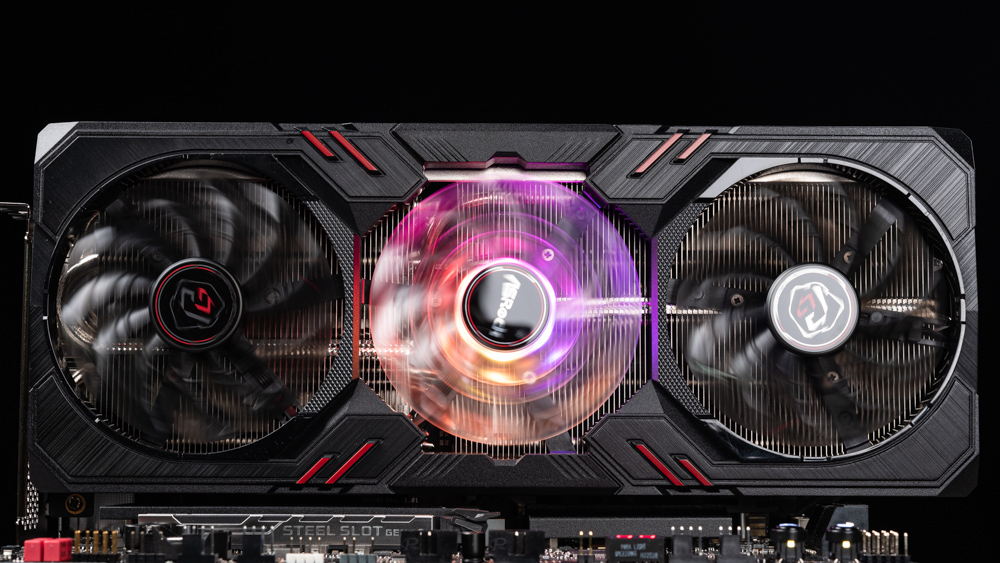
The “ASRock Arc A770 Phantom Gaming D 16GB OC” stands out as the most affordable 1440p gaming GPU featuring a sizable 16GB of VRAM, along with full support for DirectX 12 Ultimate and decoding for both AV1 and VP9 codecs. While retaining the core attributes of the Arc A770 8GB model available, this version boasts an enhanced memory capacity. This upgrade contributes to expanded memory bandwidth, thus enabling 2K gaming enthusiasts to experience advanced functionalities, including ray tracing and the AI-driven XeSS upscaling technology.
Key Features:
- Graphics Processor: Intel Arc A770
- Interface Type: PCIe 4.0 x16
- Core Speed: 2200 MHz
- Total Xe Cores: 32
- Ray Tracing Cores: 32
- XMX Processing Engines: 512
- Video Memory: 16GB GDDR6
- Memory Speed: 17.5 Gbps
- Memory Bus Width: 256 bits
- Video Outputs: Three DisplayPort 2.0 ports, one HDMI 2.1 port
- Power Connectors: Two 8-pin
- Minimum PSU Recommendation: 700 Watts and above
- Physical Size: 305 mm x 131 mm x 56 mm, occupies 2.8 slots
- Weight: 1146 grams
ASRock Arc A770 Phantom Gaming D 16GB OC unboxing/full fin three-fan
The Arc A770 Phantom Gaming graphics card has been enhanced to include a hefty 16GB of VRAM while maintaining its original Xe HPG micro-architecture. It encompasses 32 Xe-Core units, 32 ray tracing units, and 512 XMX engines. Out of the box, the card is overclocked to a 2200MHz pulse rate and sports an improved 16GB GDDR6 memory across a 256-bit interface, with memory bandwidth pushed to 17.5Gbps.
Power-wise, the Arc A770 Phantom Gaming D 16GB OC requires two 8-pin PCIe connections, with a recommendation that the power supply should deliver at least 700W to ensure stable operation. In terms of cooling, the card is equipped with the Phantom Gaming 3X cooling system. Aesthetically, it features a Polychrome RGB fan at its core, alongside the distinctive Phantom Gaming RGB branding on the side. The card’s design is marked by a sleek black base with red lines and RGB highlights that resonate with the Phantom Gaming style.
Dimensionally, the card measures 30.5cm in length and 13.1cm in height, occupying a 2.8-slot space within the PC case. For display outputs, it offers the capacity to connect four screens simultaneously through three DisplayPort 2.0 ports and one HDMI 2.1 port.
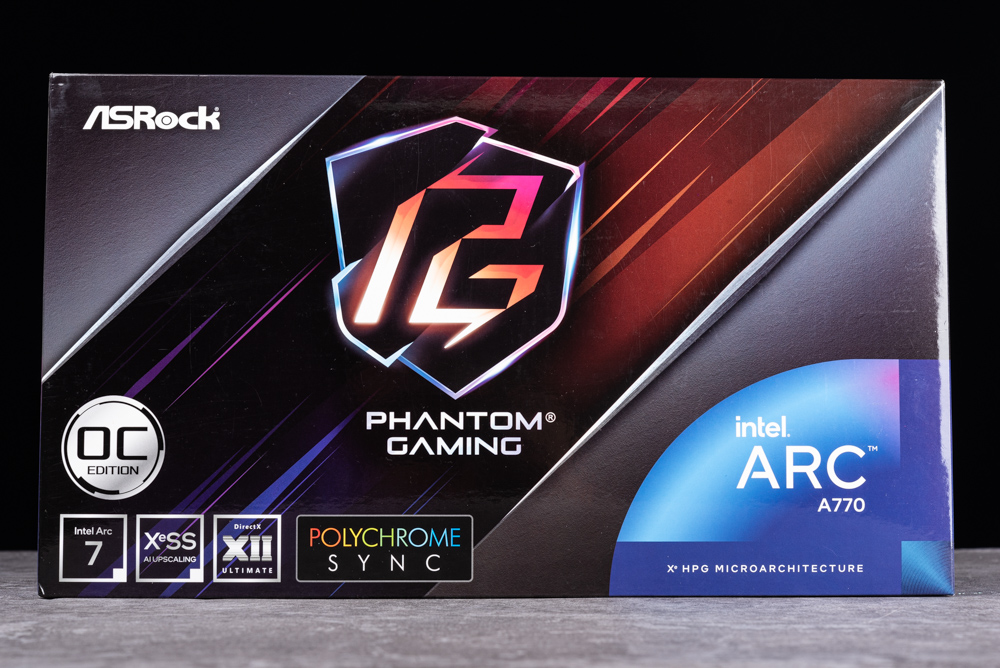
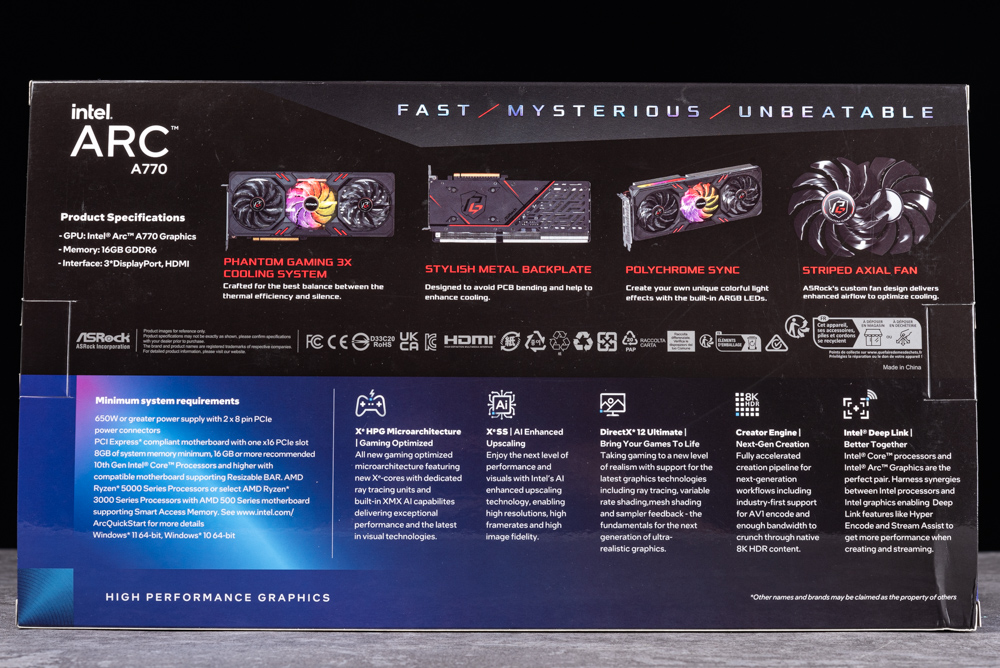
The Arc A770 Phantom Gaming D 16GB OC has a robust 30.5cm triple-fan cooling system for efficient temperature management. The centerpiece of this system is a fan adorned with Polychrome RGB lighting effects and transparent blades, which contrast with the subtle black blades of the flanking fans. This striking arrangement is accented with sharp red lines, contributing to the cooler’s aggressive aesthetic and complementing the overall gaming-oriented design of the card.
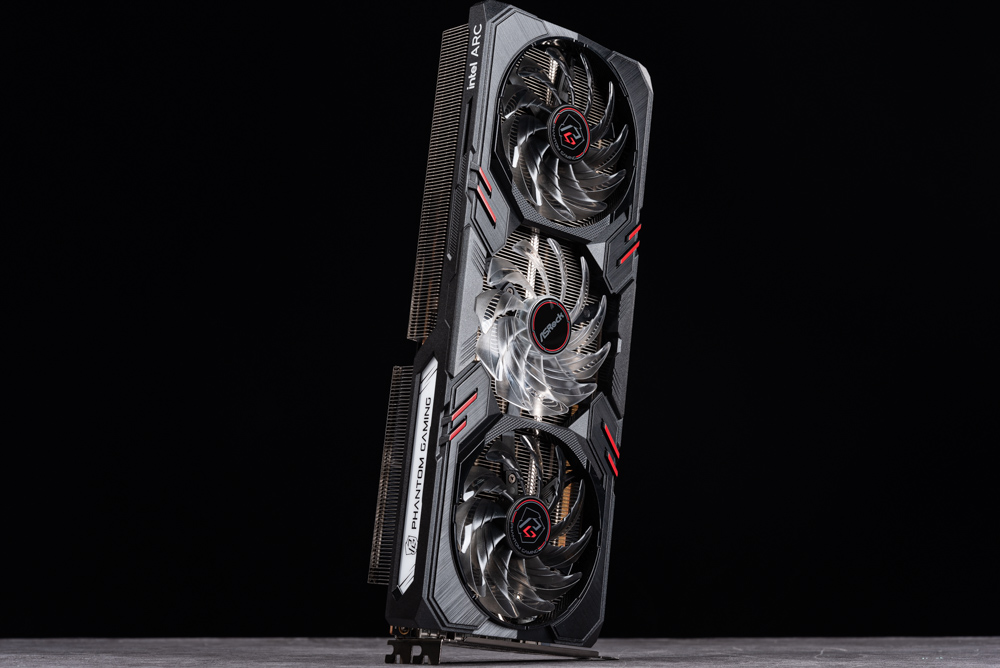
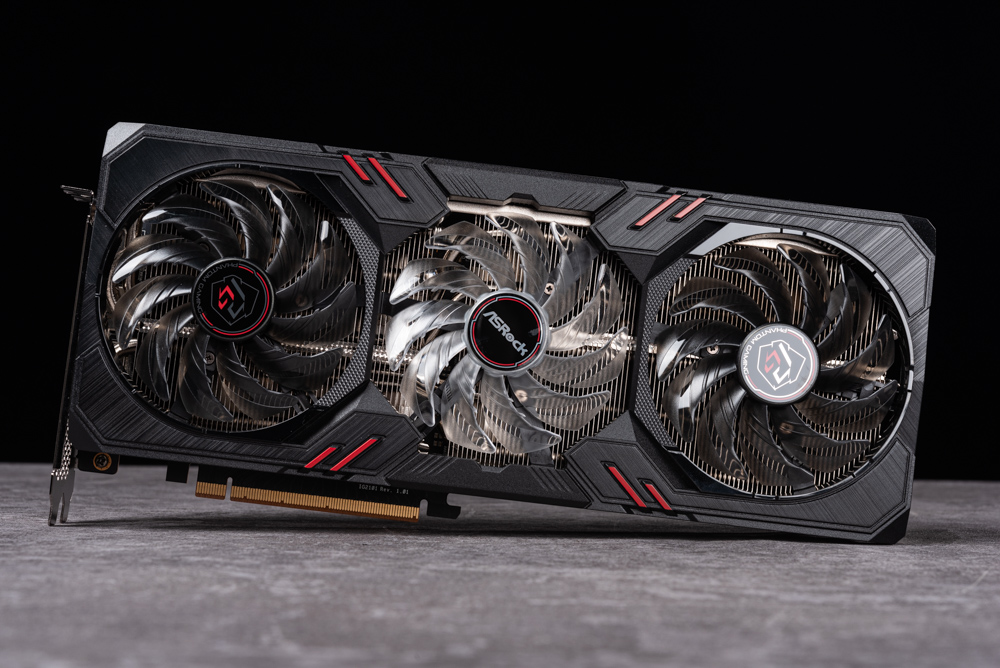
The Arc A770 Phantom Gaming D 16GB OC graphics card features an expanded 13.1cm tall cooling fin array, significantly contributing to its heat dissipation capabilities. Along its side, it boasts Phantom Gaming RGB lighting effects and proudly displays the Intel ARC branding. The card is designed with a compact circuit board to fit these components efficiently and requires two 8-pin PCIe power connectors to meet its energy needs. Additionally, it is fitted with an attractive metal backplate on the reverse side, which not only adds to the card’s aesthetic appeal but also enhances the passive cooling of the memory modules located at the back of the card.
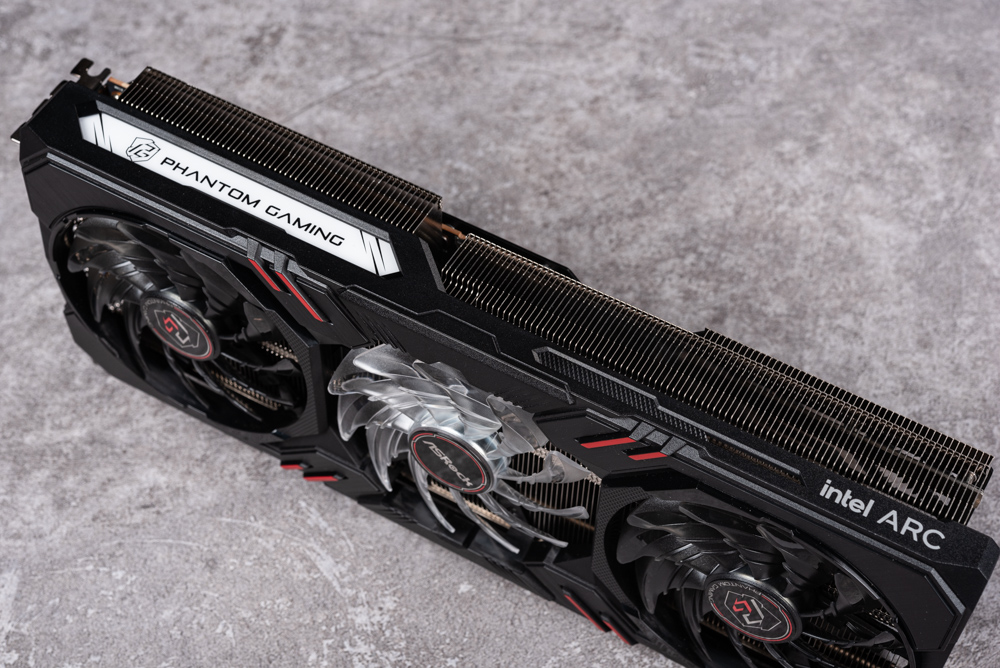
The side of the Arc A770 Phantom Gaming D 16GB OC graphics card showcases the Phantom Gaming branding in RGB lighting, which illuminates to give a dynamic visual appeal that gamers often appreciate. This feature, combined with the complete array of cooling fins that span the card’s height, highlights its design focus on both style and functionality. These cooling fins are essential in thermal regulation, ensuring the card operates efficiently despite high-performance demands.
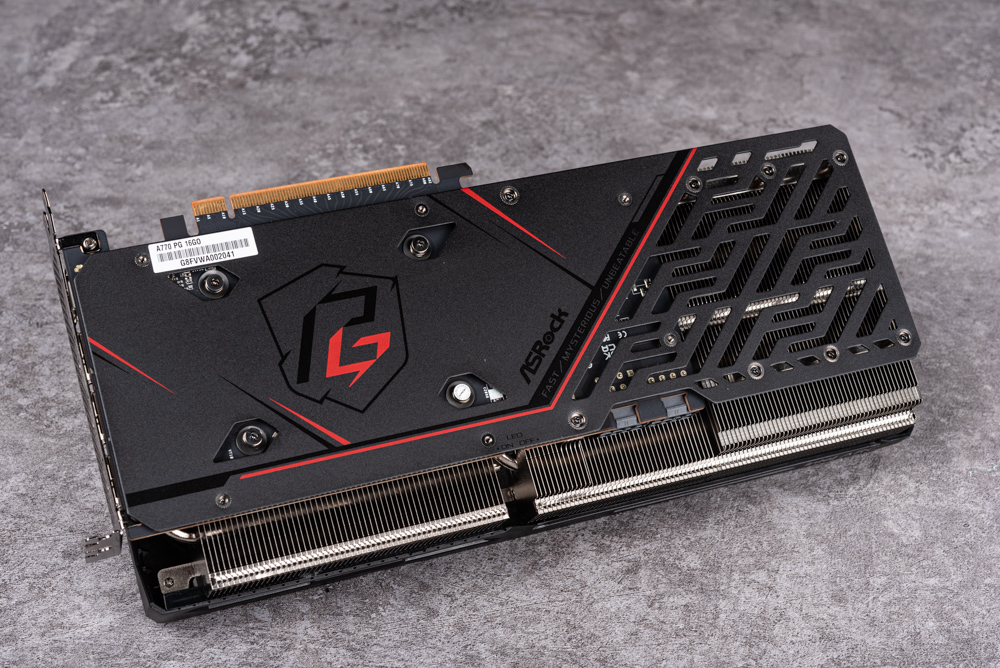
The Arc A770 Phantom Gaming D 16GB OC graphics card is constructed with a metal backplate, which not only adds structural rigidity but also contributes to cooling efficiency. The front of the card includes strategically designed openings that permit airflow to pass through, facilitating enhanced heat dissipation. This design ensures that the card maintains optimal operating temperatures, thereby improving performance and longevity. Integrating these openings with the cooling system allows for a continuous flow of air, which is crucial for maintaining thermal balance during intensive gaming sessions or heavy workloads.
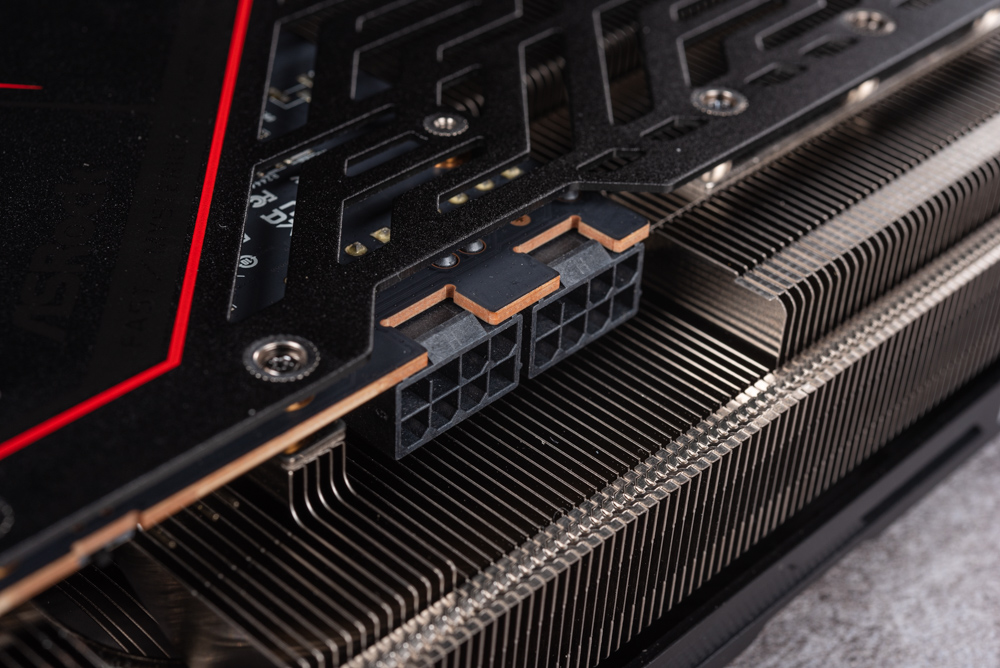
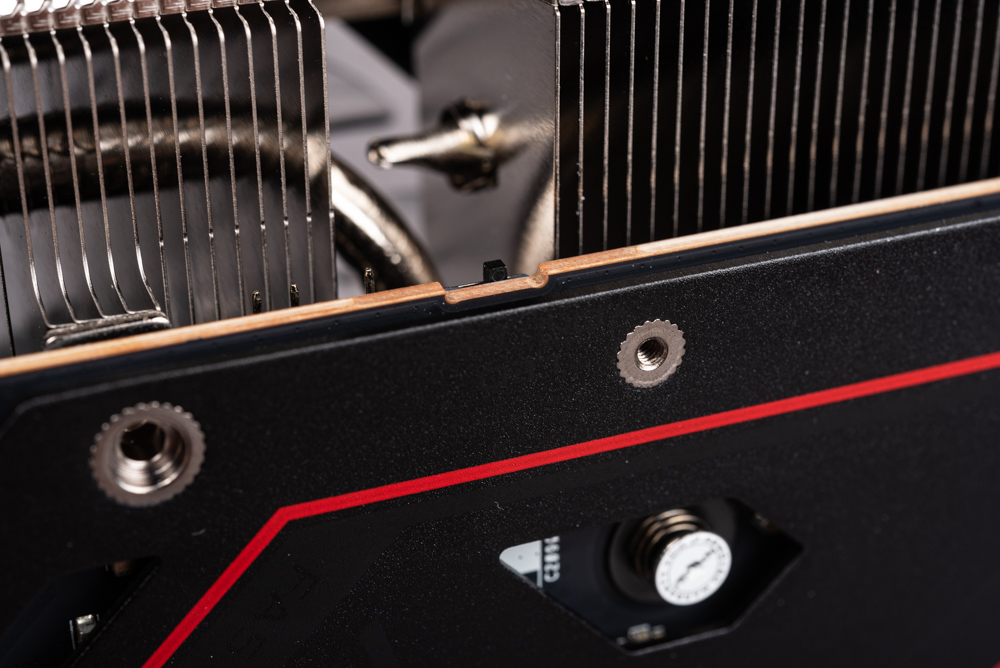
The graphics card output provides 3 DisplayPort 2.0 and 1 HDMI 2.1, which can connect up to 4 screens simultaneously.
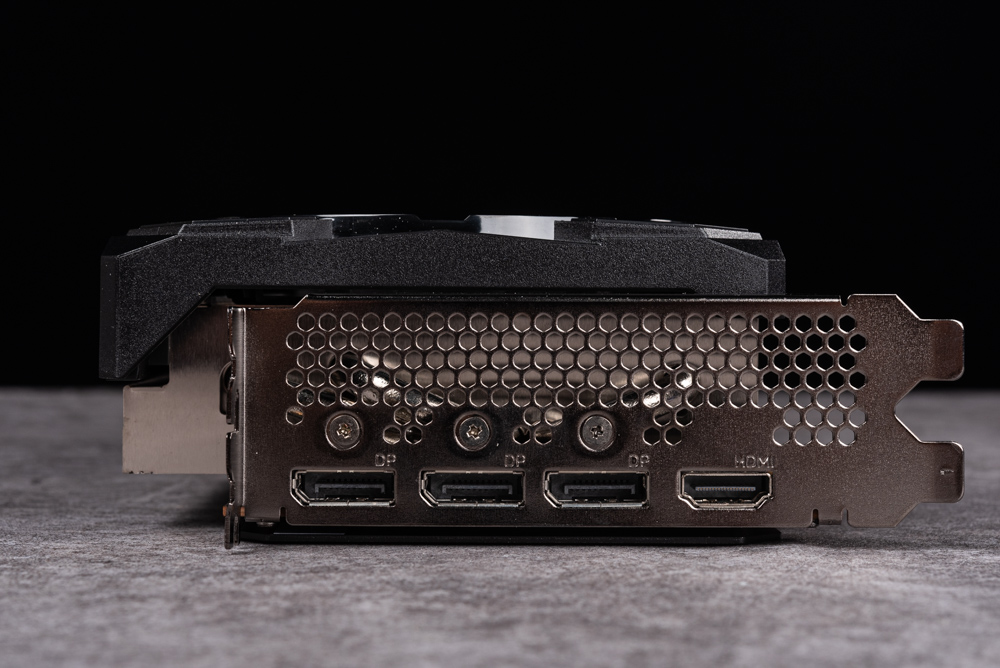
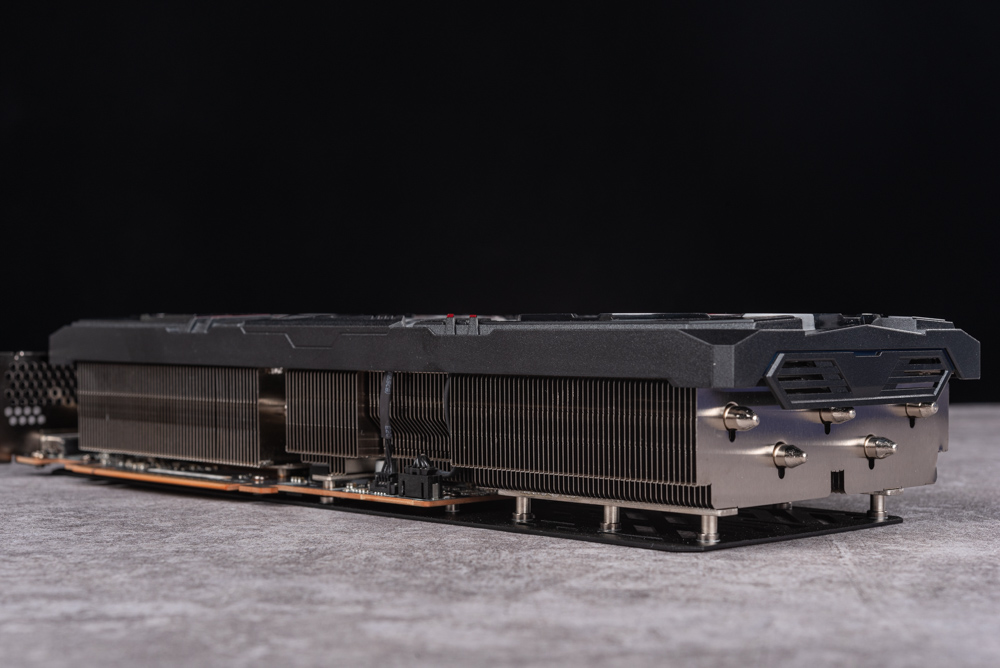
Upon disassembling the Arc A770 Phantom Gaming D 16GB OC graphics card, one would observe that its compact circuit board design serves a specific purpose: it allows the front airflow to pass unimpeded through the heatsink, which is integral to the card’s cooling efficiency. The heatsink itself is securely attached to the metal backplate, which contributes to the card’s overall stability and heat dissipation capabilities.
However, due to its considerable length and weight distribution, when mounting the card horizontally in a PC case, it’s advisable to use a support bracket at the front end. This precaution helps to prevent any potential sagging caused by gravity over time, which could otherwise lead to physical stress or even damage to the PCIe slot or the card itself.
The cooling system is meticulously engineered, featuring a copper base directly interacting with the GPU for optimal thermal transfer. From this base, heat pipes extend, distributing the heat evenly to dual sets of cooling fins located at the front and back. This configuration is designed to maximize the heat dissipation across the entire surface area of the cooling fins, ensuring that the GPU and other heat-generating components are kept within safe operating temperatures under load.
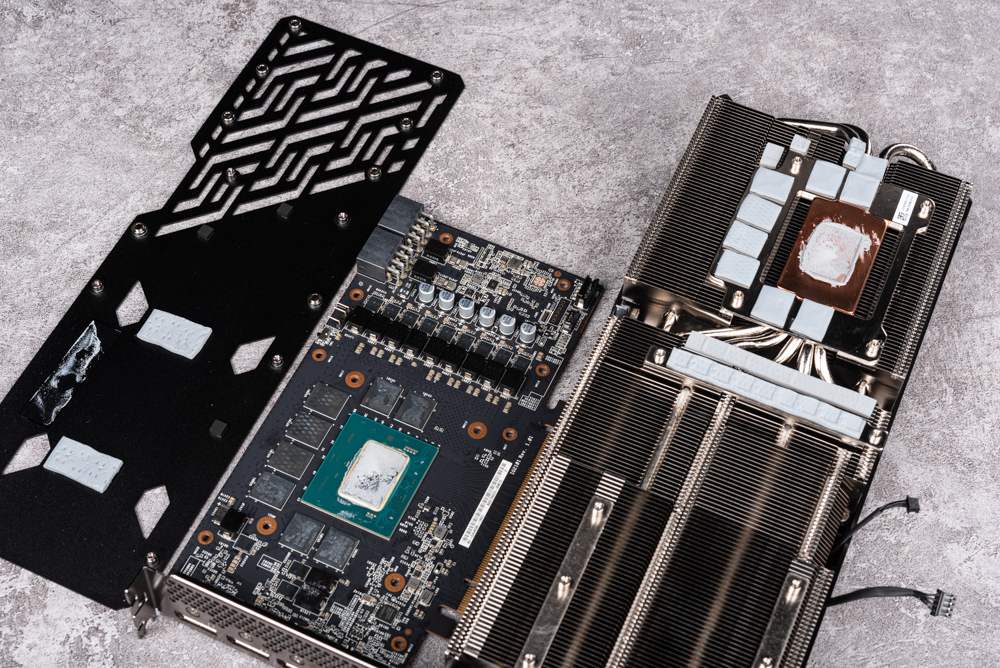
The Arc A770 graphics card is built around the ACM-G10 chip, which is fabricated using a 6nm process technology. This central processing unit is encircled by eight GDDR6 memory modules, which collectively enhance the card’s data processing and storage capabilities.
This card boasts an architecture consisting of 32 Xe-Core units, which translates to 512 shader units for rendering graphics. Additionally, it includes 32 dedicated ray tracing units for handling real-time ray tracing—a technology that simulates complex light interactions in 3D environments. The presence of 512 XMX engines, which are specialized matrix cores, empowers the card with AI processing capabilities, enhancing tasks such as deep learning super sampling (DLSS) and other AI-based image upscaling techniques.
The combination of these components makes the A770 a potent choice for gamers and professionals who require advanced graphical computations and AI-accelerated performance.
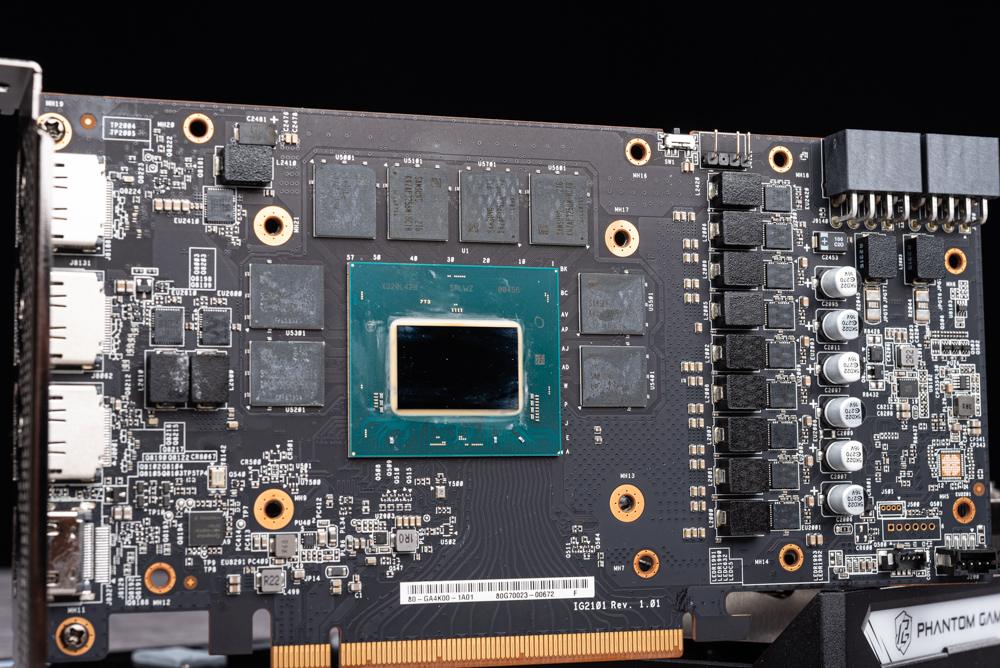
Arc control and Polychrome SYNC lighting effect software
The Arc Control software has a suite of features to enhance user experience and control over the Arc A770 graphics card. It includes essential functions like checking for driver updates and ensuring that users run the most current version for optimal performance and compatibility.
Within the Games section of the software, users have the capability to customize settings on a per-game basis, allowing for a tailored gaming experience with optimized performance and graphics settings for each individual game. This feature ensures that gamers can maximize the capabilities of their graphics card for each specific title they play.
The Performance tab offers real-time performance monitoring tools for both the graphics card and the overall system. This allows users to monitor critical parameters such as temperature, usage, and clock speeds.
The Arc Control software includes an In-Game Overlay feature. This utility lets players view hardware performance metrics in real-time without leaving or interrupting their game. It’s a convenient way to monitor the system’s behavior while amid gaming action.
Arc Control doesn’t stop at hardware management; it extends into content creation with basic streaming capabilities and video capture tools. The Highlights feature is designed to automatically capture key moments during gameplay, while the Gamera function simplifies the process of starting streams and recording gameplay videos. This suite of tools is intended to support gamers who are interested in sharing their gaming experiences through streams or recorded content, making it easier to manage their channels and content production directly through the software.
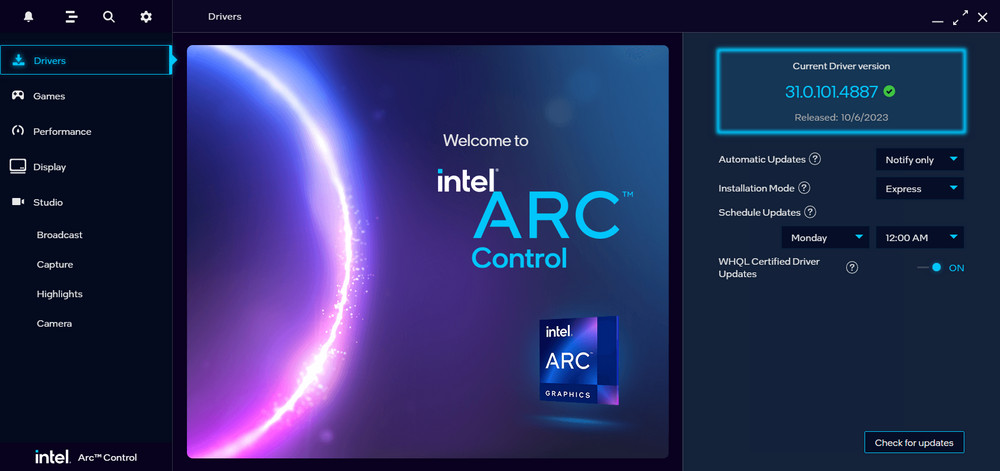
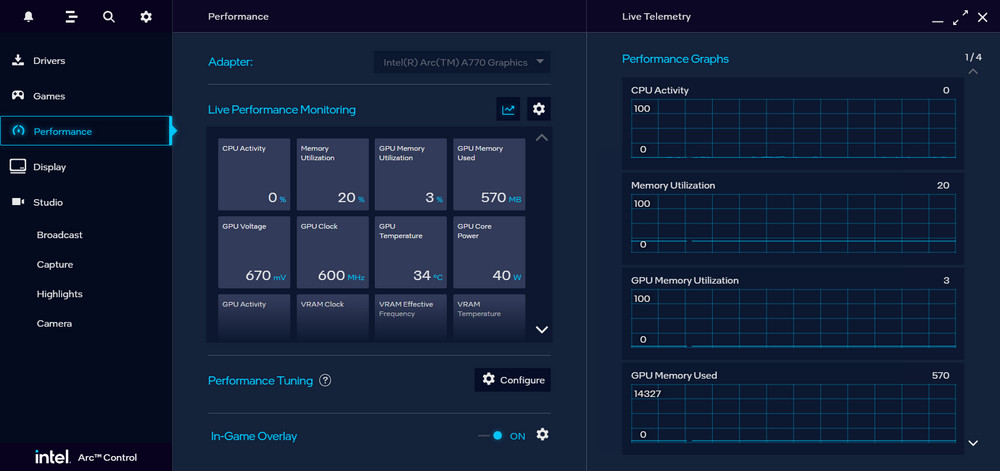
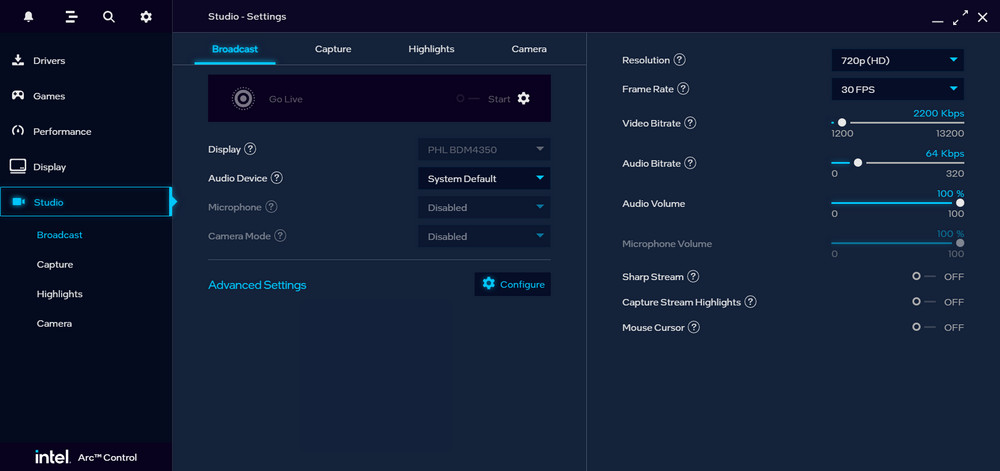
The ASRock Polychrome SYNC software is designed to give users complete control over the lighting effects on their graphics card. With this software, users can customize and synchronize the RGB lighting to match their personal aesthetic or to coordinate with other RGB components within their system.
For the Arc A770 Phantom Gaming D 16GB OC graphics card, both the fan at the front and the Phantom Gaming branding on the side of the card are equipped with RGB lighting. These lighting elements can be managed via the Polychrome SYNC software, allowing users to adjust colors, effects, brightness, and patterns to create a cohesive and visually appealing look.
By using the software, users can ensure that the lighting on their graphics card complements the overall theme of their build, whether they’re aiming for a specific color scheme or seeking a dynamic, multi-color effect that responds to system sounds, temperatures or other inputs. This level of customization is a key aspect of personalizing a gaming rig and enhancing the overall gaming experience.
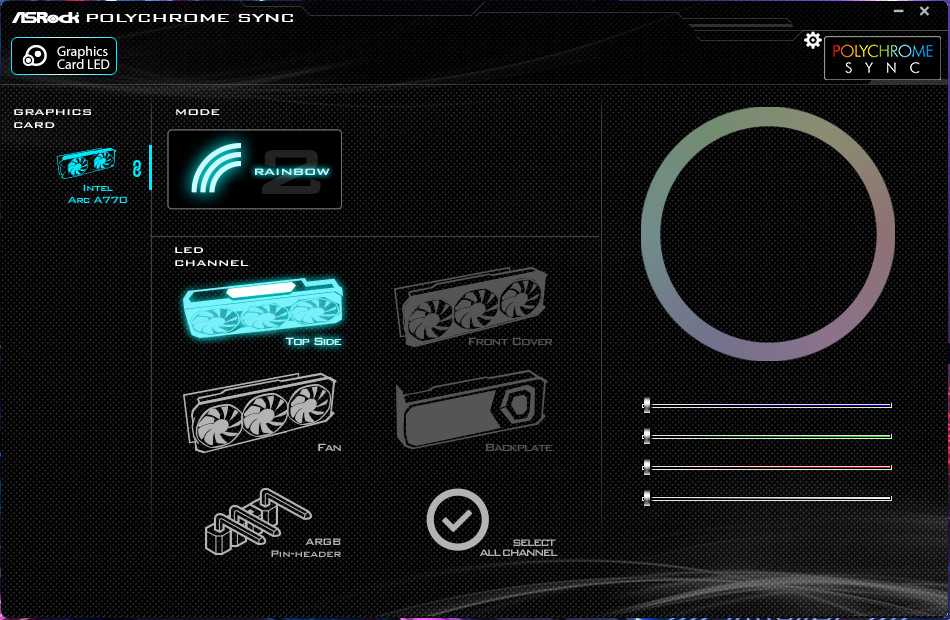
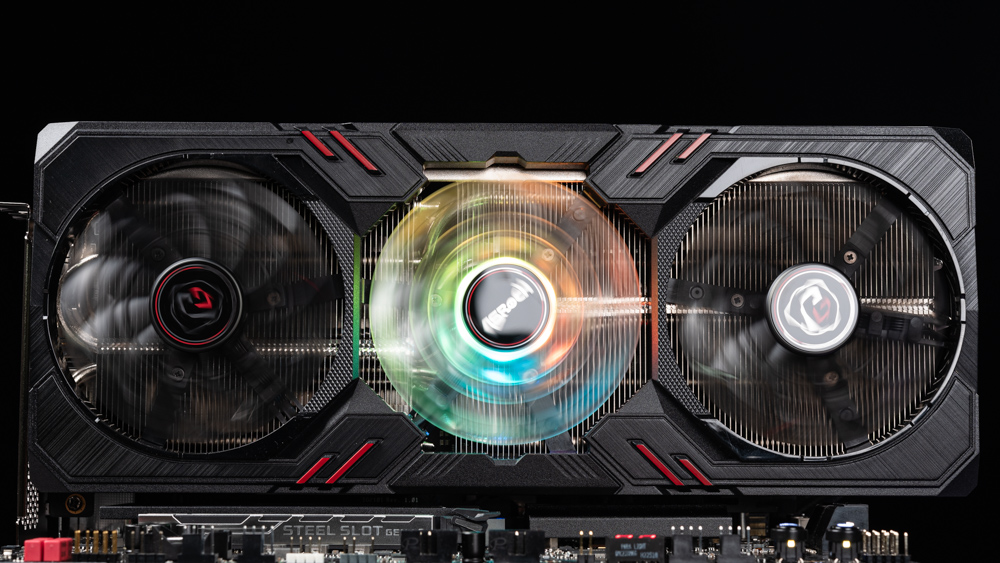
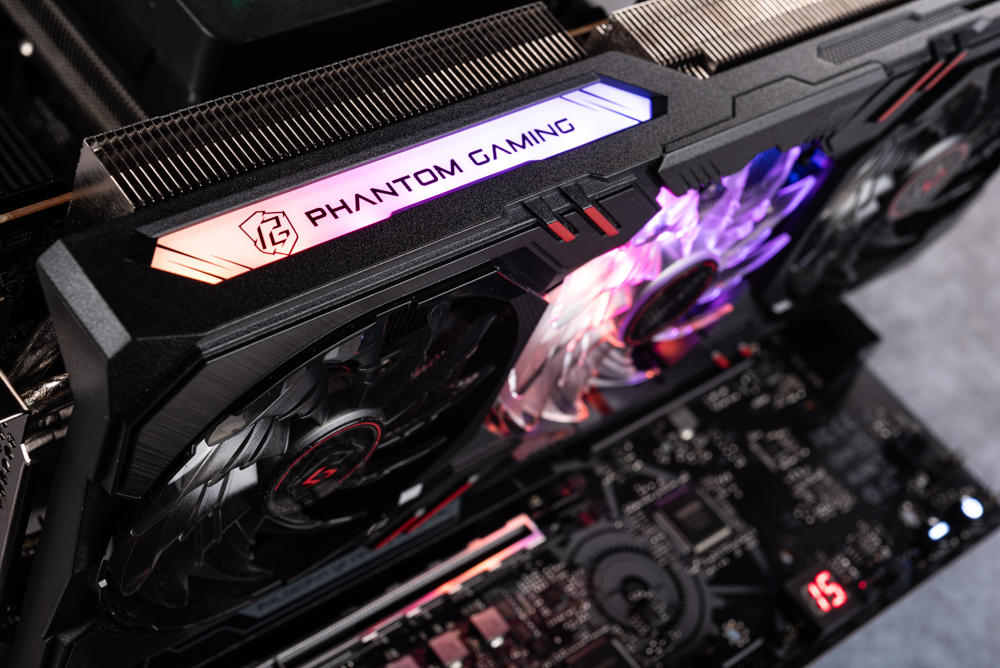
ASRock Arc A770 Phantom Gaming D 16GB OC Performance Benchmark Test
To conduct a comprehensive performance evaluation of the ASRock Arc A770 Phantom Gaming D 16GB OC graphics card, a high-end test platform is assembled, featuring an Intel Core i9-14900K CPU and the ASRock Z790 Taichi motherboard. This setup is complemented by a robust 48GB of dual-channel DDR5 memory from Crucial, clocked at 6000 MHz, which ensures that the memory bandwidth is not a bottleneck during testing.
The test rig includes the following key components:
- Processor (CPU): Intel Core i9-14900K
- Motherboard: ASRock Z790 Taichi
- Memory (RAM): Crucial Pro DDR5-6000 24GBx2
- Graphics Card (GPU): ASRock Arc A770 Phantom Gaming D 16GB OC
- System Disk (SSD): Solidigm P44 Pro 1TB PCIe 4.0 SSD
- Cooling System: 360mm AIO liquid cooler
- Power Supply Unit (PSU): Seasonic VERTEX GX-1000
- Operating System: Windows 11 Pro 22H2 64-bit with Resizable BAR enabled
- Driver Version: 31.0.101.4887
The performance testing encompasses a variety of benchmarks and real-world game scenarios:
- 3DMark: A suite of benchmarking tools to measure the GPU’s rendering ability and performance under graphically intense simulations.
- 1440p AAA Games: Testing is carried out with games that have high-fidelity graphics to assess how well the graphics card handles resolutions of 2560×1440, which is a sweet spot for many gamers.
- DXR (DirectX Raytracing) Games: These tests are included to specifically evaluate the ray tracing performance of the GPU, a demanding task that simulates realistic light behavior within games.
For accuracy and to take full advantage of the graphics card’s capabilities, features such as XMP (Extreme Memory Profile) for range overclocking and Resizable Bar, which allows full access to the GPU memory for the CPU, are enabled. This approach aims to push the hardware to its limits and provide insight into the top performance one could expect in real-world scenarios.
In the context of the GPU-Z review, it confirms the ASRock Arc A770 Phantom Gaming D 16GB OC’s key specifications, such as the utilization of the 6nm process ACM-G10 GPU, which houses 512 rendering cores and is equipped with a substantial 16GB of GDDR6 memory. The GPU’s default clock is noted at 2100 MHz, and it utilizes the PCIe 4.0 x16 interface for its bandwidth, with the specific driver version being 31.0.101.4887 and the Resizable BAR feature turned on. This comprehensive setup and detailed testing are meant to rigorously evaluate the graphics card’s capabilities in a controlled environment.
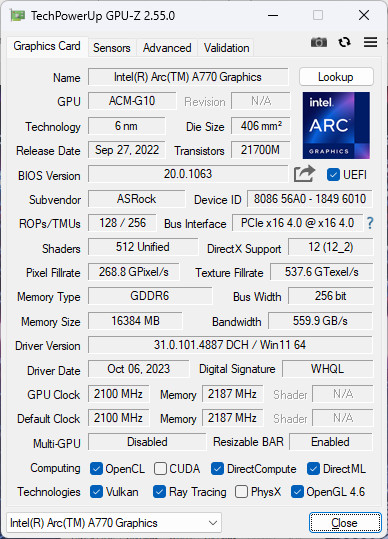
The 3DMark Fire Strike benchmark is a widely recognized test designed to gauge the performance of graphics cards using the DirectX 11 API at various resolutions. The ASRock Arc A770 16GB graphics card has showcased its capabilities through this benchmark across three different test scenarios:
- Fire Strike Performance (1080p): Aimed at standard 1080p resolution gaming, the Arc A770 16GB card scored 30,859 points. This score reflects the card’s high performance at this resolution, indicating that it should handle most games with ease, delivering high frame rates at Full HD settings.
- Fire Strike Extreme (1440p): Stepping up the resolution to 1440p, the Arc A770 16GB scored 15,657 points. This performance at a higher resolution demonstrates the card’s strong capability to manage games that require more graphical processing power, which is typical for AAA titles with detailed graphics.
- Fire Strike Ultra (4K): At the demanding 4K (2160p) resolution, the graphics card scored 7,541 points. While the score is lower compared to the lower resolutions, which is expected due to the significant increase in pixel count, it still provides insight into the card’s ability to handle 4K gaming. Gamers can expect to make some trade-offs in either frame rate or visual settings to run smoothly at this resolution.
Each of these results led to a ‘Legendary’ evaluation, signifying that the ASRock Arc A770 16GB OC performed exceptionally well within its class during the 3DMark Fire Strike tests. These scores are indicative of a graphics card that can deliver strong gaming performance across a range of resolutions, making it suitable for a wide spectrum of gaming setups, from 1080p all the way up to more challenging 4K gaming scenarios.
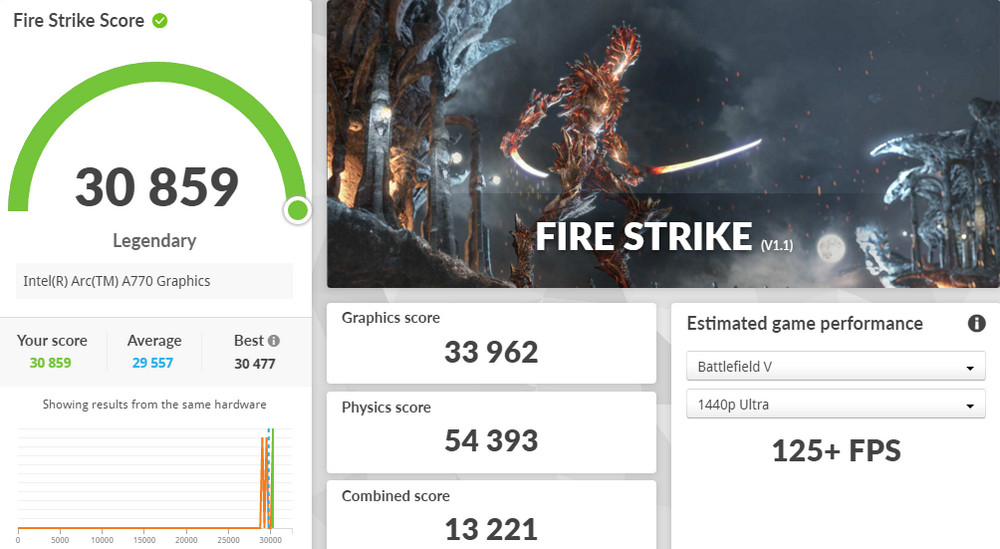
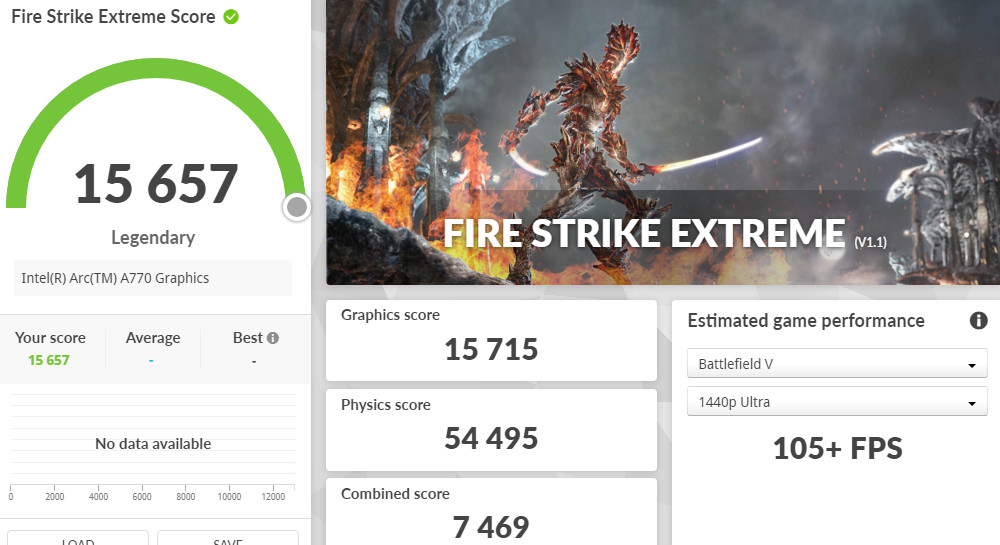
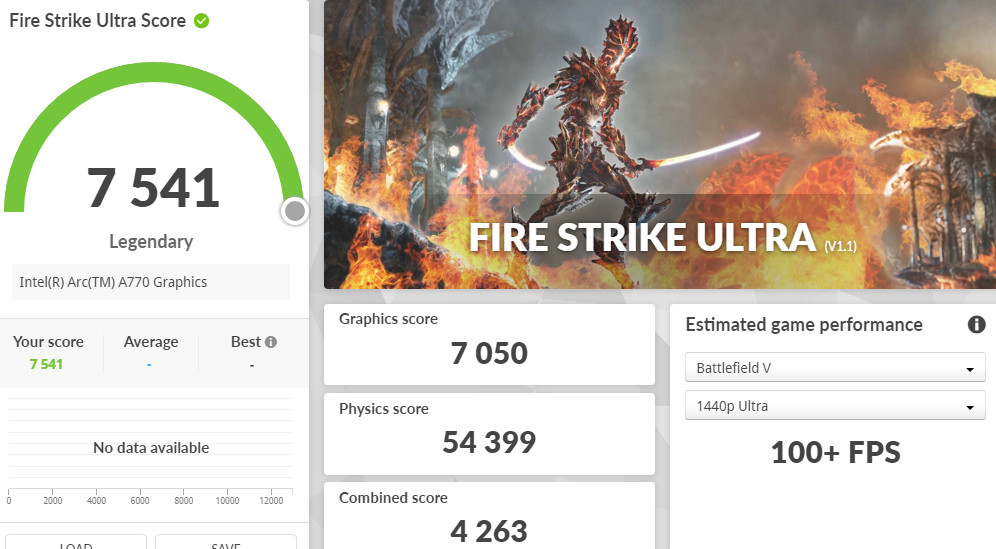
The 3DMark Time Spy benchmark is a modern test designed to assess the performance of graphics cards under the DirectX 12 API, which is particularly relevant for the latest AAA games that utilize this API for better graphics efficiency and performance. The benchmark is intended to provide a forward-looking indication of a card’s performance by using a more demanding graphics API that is more likely to be used in future games.
For the ASRock Arc A770 16GB graphics card, the scores in the Time Spy benchmark were as follows:
- Time Spy (1440p): At the 1440p resolution, the card achieved 14,528 points. This score suggests that the card is well-equipped to handle DirectX 12 gaming at this resolution, which is becoming the sweet spot for gaming enthusiasts who want a balance between high visual fidelity and performance.
- Time Spy Extreme: When the demands were increased with the Extreme version of the test, which is designed to push the limits of gaming PCs with its 4K rendering resolution, the Arc A770 16GB managed a score of 7,209 points. While this score reflects a performance decrease relative to the lower resolution, it remains a solid indicator that the card can still provide reasonable performance for gaming at 4K, albeit with potential adjustments to the game settings for optimal playability.
These scores from the 3DMark Time Spy benchmark, focusing on the DirectX 12 performance, reinforce the notion that the ASRock Arc A770 16GB is capable of delivering good performance in modern AAA titles, which often require more robust GPU capabilities, especially at higher resolutions and under the newer, more demanding DirectX 12 API.
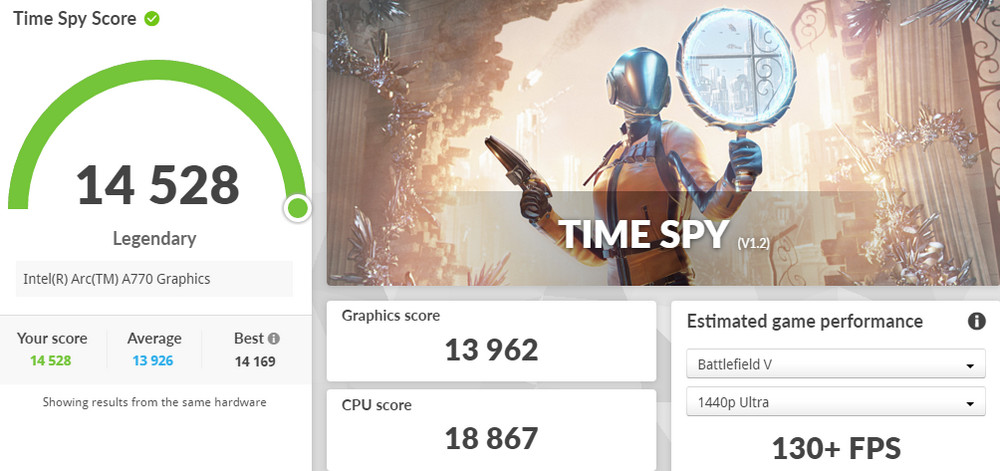
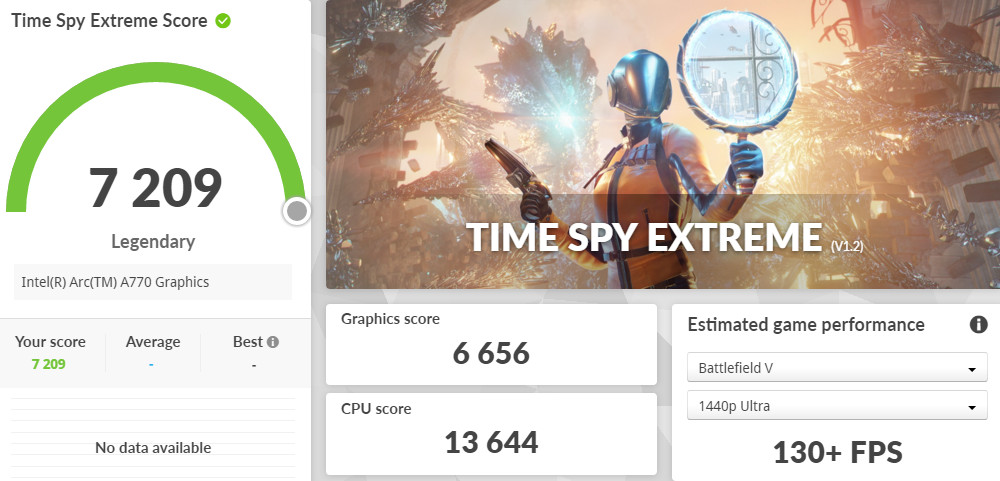
The 3DMark Speed Way benchmark is a cutting-edge testing scenario that takes advantage of the DirectX 12 Ultimate API, which encompasses a suite of next-gen graphics technologies including real-time ray tracing with global illumination and reflections, as well as Mesh Shaders. These features are designed to offer a glimpse into the future of gaming graphics, testing a graphics card’s capability to handle new and emerging visual technologies that are expected to be standard in future game titles.
In the case of the ASRock Arc A770 16GB, the benchmark score was 2,435. When interpreting this score based on the given guideline that the total score divided by 1,000 approximates the frames per second (FPS) achieved during the test, we can deduce that the card maintained an average of approximately 2.435 FPS throughout the Speed Way benchmark.
This performance level indicates that the Arc A770 16GB can reasonably handle the demands of DirectX 12 Ultimate features, which include advanced ray tracing and Mesh Shaders. However, it’s important to note that while this performance is indicative of the card’s potential in cutting-edge scenarios, actual gaming performance will vary depending on the specific games, their optimization for these features, and the settings used.
The result shows that the Arc A770 16GB is equipped to deal with the next generation of gaming graphics, although gamers might need to adjust settings for the best balance between visual fidelity and performance, especially in games that heavily utilize these advanced features.
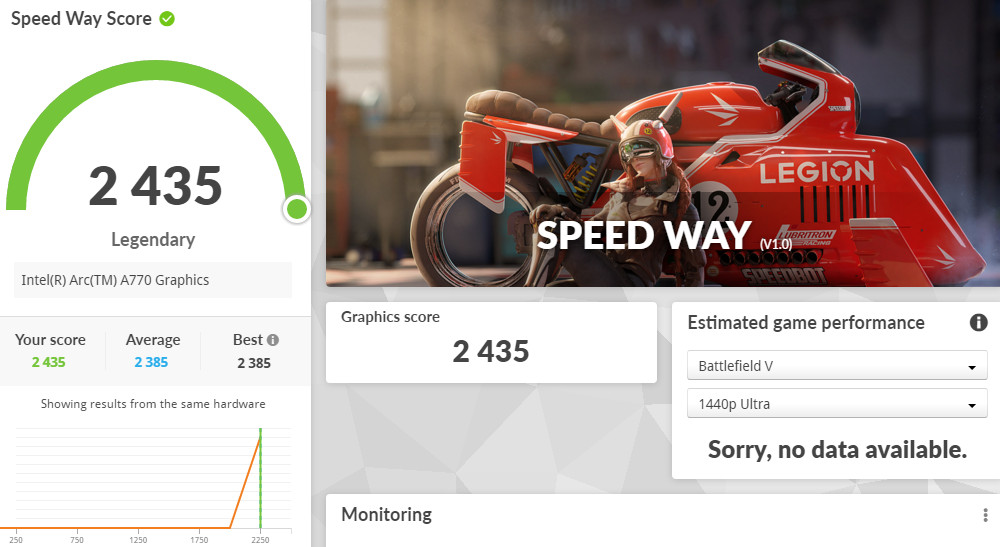
The 3DMark XeSS (Xe Super Sampling) feature test compares traditional TAA (Temporal Anti-Aliasing) with Intel’s XeSS upscaling technology. This test provides insight into how well a graphics card can enhance image quality while also improving performance when using AI-driven upscaling techniques as opposed to standard anti-aliasing methods.
For the ASRock Arc A770 16GB:
- With TAA: When using TAA, the card achieved 14.02 frames per second (FPS). This framerate reflects the demanding nature of TAA, which can provide good image quality by reducing the aliasing effect but often at the cost of performance, especially in complex scenes with ray tracing.
- With XeSS: After enabling XeSS, the framerate significantly increased to 43.33 FPS. This represents a performance improvement of approximately 194.7% over TAA. XeSS is designed to intelligently upscale images from a lower resolution, which means it can render frames at a lower computational cost and then upscale them to the target resolution with AI processing to enhance image details and maintain quality.
The substantial increase in framerate demonstrates the effectiveness of XeSS at boosting performance while still delivering high-quality visuals. It’s particularly noteworthy that such technologies allow for better ray tracing performance, which is traditionally very resource-intensive. This performance leap highlights the potential of AI-driven upscaling technologies like XeSS to enable higher framerates without compromising on visual fidelity, making advanced graphics features more accessible on hardware that might otherwise struggle with such demanding tasks.
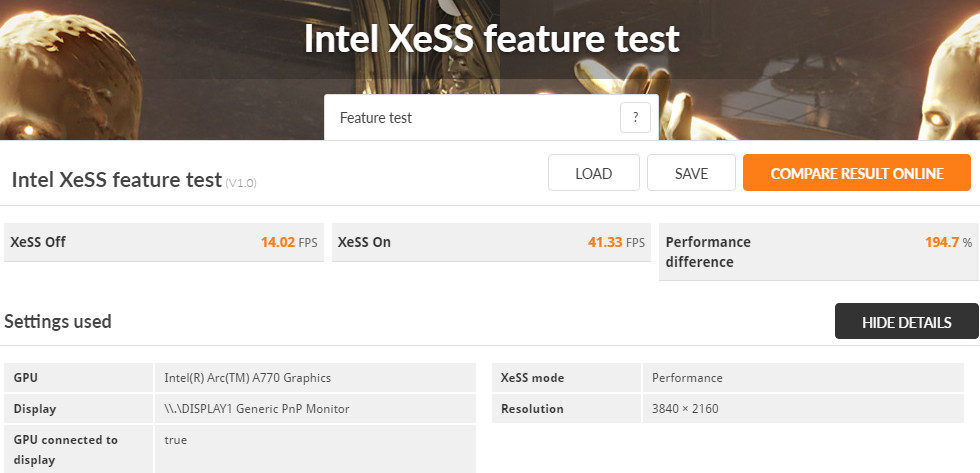
ASRock Arc A770 Phantom Gaming D 16GB OC – Performance Test of 4 E-Sports Games
The ASRock Arc A770 16GB graphics card has been tested on four popular esports titles at high settings and 1440p resolution, achieving impressive frame rates that indicate excellent performance for competitive gaming:
- “CS2: Force 2” (likely Counter-Strike): The card delivered an average of 120 FPS. This performance level is well above the 60 FPS standard for smooth gameplay, providing a competitive edge with smooth rendering for fast-paced action.
- “APEX Legends”: With an average of 161 FPS, the A770 16GB offers a fluid and responsive experience, which is critical for this fast-paced battle royale game, where quick reflexes and sharp visuals can make a significant difference.
- “League of Legends”: Averaging 525 FPS is well beyond what’s required for this title, which isn’t as graphically demanding as other games. The A770 provides headroom for maximum settings and ensures that even in the most chaotic team fights, the action remains crystal clear and without any lag.
- “Rainbow Six: Siege”: An average of 244 FPS is excellent, especially considering that “Rainbow Six: Siege” is a game where precision and quick reaction times are crucial. High frame rates contribute to a smoother experience, reducing motion blur and input lag.
These results demonstrate that the Arc A770 16GB can easily handle the demands of competitive esports titles at 2K resolution, providing gamers with the high frame rates necessary for an enjoyable and competitive gaming experience. For players who prioritize frame rate and responsiveness to gain a competitive advantage, this card appears to be a solid choice, offering high performance in a range of well-loved esports games.
ASRock Arc A770 Phantom Gaming D 16GB OC – 9 games performance test
The ASRock Arc A770 16GB graphics card has been benchmarked on a suite of nine demanding AAA games at 1440p resolution with all settings maxed out, revealing its performance across a variety of gaming genres:
- Average Performance Across Nine Games: With an average of 76.12 FPS across all tested titles, the card demonstrates a strong capability to handle modern, graphically-intensive games at a high resolution, providing an enjoyable and smooth gaming experience.
- “Starry Sky” (Title unspecified, could refer to a space-themed game): Achieving 37 FPS on average, which suggests that this particular game is quite demanding or perhaps not fully optimized. The use of FSR2 (FidelityFX Super Resolution 2.0) by default is an attempt to boost frame rates without compromising too much on visual quality.
- “Diablo IV”: With an average of 94 FPS, this indicates that the card handles the game very well, providing more than enough performance headroom for a smooth gaming experience in this action RPG.
- “Red Dead Redemption 2”: Averaging 64.3 FPS is a solid performance, especially for such a demanding game known for its extensive graphics settings and detailed open world.
- “God of War”: The average of 48 FPS indicates that this highly detailed and visually impressive title is pushing the boundaries of what the card can do at ultra settings in 1440p. However, it remains close to that smooth 60 FPS mark, which can likely be achieved by enabling FSR to upscale from a lower resolution.
The mention of FSR technology for “Starry Sky” and “God of War” is noteworthy. FSR, or FidelityFX Super Resolution, is AMD’s upscaling technology that aims to increase frame rates by rendering games at a lower resolution and then upscaling them to the target resolution, enhancing performance without significantly degrading visual quality. When games are particularly performance-heavy, technologies like FSR can be very beneficial in maintaining higher frame rates while still providing an immersive gaming experience.
Overall, these results illustrate that the ASRock Arc A770 16GB is quite capable of running the latest AAA titles at 1440p, with most games running comfortably above 60 FPS. For the most demanding titles, tweaking settings or leveraging upscaling technologies can provide a more fluid experience.
ASRock Arc A770 Phantom Gaming D 16GB OC – 7 ray tracing DXR game tests
The ASRock Arc A770 16GB GPU has undergone performance testing with seven ray tracing-capable games, showcasing how it handles some of the most graphically demanding scenarios at 1440p resolution:
- Overall Ray Tracing Performance: The average frame rate across these seven ray tracing-enabled titles was 112.4 FPS, which at first glance seems quite impressive. However, this average may be skewed by some titles performing exceptionally well, which can elevate the overall figure.
- “Star Wars Jedi: Survivor”: With only 30 FPS even after FSR2 (FidelityFX Super Resolution 2.0) acceleration, it’s clear that the intense demands of ray tracing at high resolutions are pushing the GPU to its limits. For more fluid gameplay, players may need to compromise on either resolution or graphical settings.
- “Spider-Man: Miles Morales”: The card fares better in this title, with XeSS (Intel’s Xe Super Sampling technology) acceleration boosting performance to an average of 84 FPS, suggesting a more balanced combination of visual fidelity and frame rate.
- “The Witcher 3: Wild Hunt”: With XeSS acceleration, the average frame rate is around 50 FPS. Considering the age of the game, this performance indicates that the implementation of ray tracing and upscaling technologies still demands significant GPU power.
The information provided reflects that while the ASRock Arc A770 16GB is capable of ray tracing, achieving stable and high performance in the most demanding titles with all the visual effects turned on can be a challenge. It appears that in games with heavy ray tracing loads, the current iteration of XeSS, while helpful, is not sufficient to maintain high frame rates without some compromises.
For gamers aiming for smoother gameplay in these titles, lowering some graphical settings may be necessary. This adjustment would balance the visual enhancements that ray tracing provides with the need for a fluid gaming experience, especially in action-packed scenes where higher frame rates are crucial for responsiveness.
ASRock Arc A770 Phantom Gaming D 16GB OC Power Consumption and Temperature
The graphics card’s power consumption and temperature were tested using the Time Spy Extreme Stress test, FurMark, and “Dynasty 2077”.
In terms of graphics card temperature, the maximum temperature of the Arc A770 Phantom Gaming D 16GB OC stress test was maintained at 76°C, and the overall temperature suppression performance can be said to be quite excellent. Regarding power consumption, the Furmark test is as high as 210W, and the 2077 game is at 174W. It is recommended that players install a power supply with a power supply of more than 700W.
Summarize
ASRock Arc A770 Phantom Gaming D 16GB OC has a handsome Phantom Gaming three-fan cooling design with a copper base, heat pipes, and large-area cooling fins, giving the GPU considerable cooling capabilities, while the A770 16GB memory version is more suitable for 1440p AAA gamers Performance requirements, but if it is a light chasing masterpiece, you need to fine-tune and lower the settings.
However, there are currently very few Intel graphics cards on the market in Taiwan, and there are no signs of sales of the ASRock Arc A770 Phantom Gaming. However, the Arc A770 16GB graphics card currently found on the Internet should be priced at around 11,000 yuan. This price is in line with the market price at the time of publication. The selling price is similar. That is, adding VRAM is a small upgrade at no additional price.
If this article is helpful for you, please share this article with your friends on social media. Thank you!
This article is based on the personality of the reviews. You are responsible for fact-checking if the contents are not facts or accurate.
Title: ASRock Arc A770 Phantom Gaming D 16GB OC: The Budget-Friendly 1440p Powerhouse for Gamers